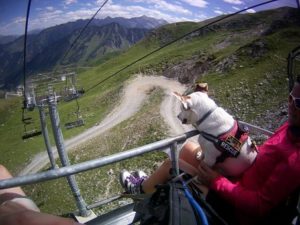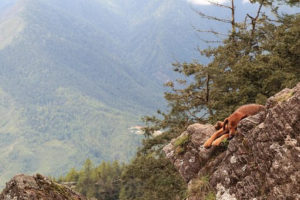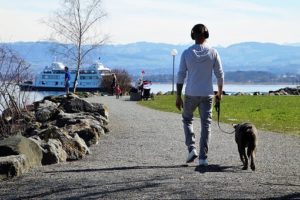Hiking and traveling
“Dogs are man’s best friend”, or so the old adage goes. They guard and protect us, give us unconditional love and companionship, lift our spirits when we are feeling down. There is nothing that a dog won’t do for “the leader of the pack”. Likewise, there is nothing a person won’t do for their beloved canine companions.

A dog’s sense of smell is about 40 to 50 times greater than a human, and it’s hearing is about four times greater. By scent alone, a dog can lead a person to something magical in the wilderness, a plant they’ve never seen before, or an encounter with a wild animal, that they likely would have missed if traveling alone. Plus, in the wild, with their heightened senses, a dog is much more likely to be aware of any potential risks or danger well before it arrives. Humans seem far less defenseless to wild predators with a dog in their midst. And, most of the time, while dogs are not likely to travel far away from the human pack, those heightened senses are not infallible. For example, if a dog gets carried away and rushes off following the scent of what it’s instinct considers prey, for example, and dashes across a wide stream it may possibly lose the human scent of their companions since scents don’t carry through water.
Tools
So traveling becomes a perfect opportunity for man to be “dog’s best friend,” if the right tools are brought along. Tools such as a GPS dog fence which can help the protected become the protector if something happens to go wrong. After all, while a dog’s instincts are sharper than their human’s, after millions of generations, since their domestication, they are nowhere close to their ancestors, or their cousins, still living in the wild. A wolf in the wild will know their own territory like a domesticated canine knows it’s own neighborhood, but will also have a better chance at tracking the pack even in unfamiliar territory. If a dog gets lost in an area it is familiar with, it will likely show up at home within a few hours. But in unfamiliar terrain, with the excitement of new scents and sounds, anything can happen. With a GPS collar, what could have been a family disaster can quickly become a real-life family adventure, complete with maps and a “treasure-hunt.” The “X” that “marks the spot” might move a bit on the map, but it’s a treasure that’s guaranteed, if the situation occurs where you have to hunt for it. If the dog has minor injuries, then the kids have an opportunity to learn about both first-aid, and veterinary medicine at the same time. The family camping trip is still an adventure, just with a little unplanned extra excitement added in.

There are a few downsides to traveling with canine companions, but not many. Some modes of travel, such as trains and airplanes, are not conducive to pet travel. And while possible, it can be extremely stressful for your dog, leaving emotional anxiety which has the possibility of extending through the remainder of the trip. Also, it’s just not possible to take the four-legged family member everywhere, and leaving your dogs in the car while you visit the local museum or have a nice dinner is not healthy or fair to them. Plus, it defeats the purpose of bringing them on the family vacation. Bringing the dogs, while adding fun and excitement does also mean that extra gear must be packed for them as well. Things like dog food (and the bowls for it), leashes, and the GPS collar to ensure that the trip doesn’t end in disaster.
Traveling with a dog

Dogs, like their people pack leaders, love to travel, love to explore and get “back to nature.” Having a canine companion reduces stress, as does being in a natural environment. Combining the two is a natural recipe for good mental health and alleviating or avoiding depression. Plus, as we get older, we lose motivation, meaning and purpose in our lives. Owning a dog, and traveling with it can bring back that desire, that fire, that zest for life. Dogs don’t sit still, and won’t be ignored. Even if the trip is one where camping in one location is the object of the trip, dogs need to be walked often. On a long road trip, more frequent stops will be required, which also means more exercise for the people on the trip too, which in turn means better heart health, stamina, better blood circulation and more.
Since bringing your dog also makes you look more like a local, real locals are also much more likely to stop and chat with you too. Through them you can find out about hidden gems that only a person from the area would know about, places that won’t be listed in a guidebook or on a map. They can provide advice on emergency needs too: whose the best mechanic if the vehicle breaks down or where the emergency vet is just in case. Plus, locals always know the best restaurants and places to grab a quick bite to eat, and many will know where the dogs can get extra treats.
Planning a trip

Barring any unforeseen circumstances or emergencies, and having been successfully prepared for them in case they do occur, eventually the trip has to end and everyone has to return home to restart the regular routine. This can be as difficult and depressing for the four-legged members of the family as it is for the two-legged ones. For the duration of the trip, it’s been outside the norm, exciting, adventurous, liberating, with something new and different often several times a day. On the road there’s a sense of freedom for both people and dogs that just cannot be felt at home. There doesn’t have to be any schedules, nor any specific place to be at any specific time. Once the trip is over, everyone is out of car, the luggage is unloaded and the gates are closed, there’s an emotional sense of loss which can take up to a week to dispel and for life to settle back down to normal. With the canine kids it can be particularly difficult, as many will often try and escape back for another taste of the freedom they had during the trip. Taking them on walks through their home “territory” and playing fetch or tug-of-war will help, and with a little time and lots of love, they too will soon settle back into their normal routine.

Traveling with your canine companions is not much different than returning to our historical roots. It’s the joy of being nomads, looking for the next stop. Giving safety, security, protection and emotional support to each other. There’s still very little that has changed in the bond between our ancestors and theirs. Still growing, still learning, still training, still doing the same things together and often in the same ways. Sitting under the stars with your best friend by your side, and his best friend by his, a small fire burning down to embers and ash, it’s not difficult to imagine that the dog by your side might be a long distant offspring of the same dog that sat by the side of your long distant ancestor. It’s easy to believe that the scrap of food you just tossed him isn’t much different that the scraps of food that brought the original pack together. Those are the moments when it’s easy to see that not much has changed in the world. And those are the moments that give every reason in the world to take every vacation, every trip you can with your canine family. It’s his world, and his vacation too.
![Best Cheap Dog Foods - our Top 10 Picks of High Quality Brands That Are Still Affordable [Under $1 per pound!] in 2023 Best Cheap Dog Foods - our Top 10 Picks of High Quality Brands That Are Still Affordable [Under $1 per pound!] in 2023](https://shihtzuexpert.com/wp-content/uploads/2018/01/Best-Cheap-Dog-Food-Featured-image.png)

![10 Best Dog Crates for Separation Anxiety [High anxiety dog crates 2019 Reviews] 10 Best Dog Crates for Separation Anxiety [High anxiety dog crates 2019 Reviews]](https://shihtzuexpert.com/wp-content/uploads/2019/05/5-3.jpg)
![12 Best Dog Clippers for Shih Tzu [Fun & Easy Grooming] 12 Best Dog Clippers for Shih Tzu [Fun & Easy Grooming]](https://shihtzuexpert.com/wp-content/uploads/2017/04/Best-Dog-Clippers-for-Shih-Tzu-1.png)
